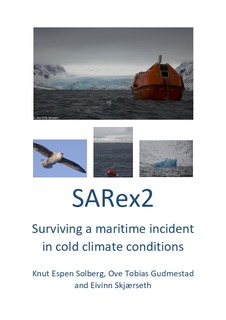| dc.description.abstract | To comply with the IMO Polar Code requirement regarding survival in a rescue craft until rescue or for a minimum of five days has proved to be a hard and complicated endeavor. Multiple mechanisms are at play and interact. As a result, survival is not only about providing the correct equipment with the right functionality, it is also about physical and mental robustness and the ability to conduct the right tasks for the duration of the stay.
The SARex exercise proved that the margins determining survival are very small and there is no room for error. Strong leadership is essential, and the rescue craft captain’s knowledge and experience are critical factors for success. This is currently not addressed in the standard maritime training regime.
Maintaining an adequate body temperature is essential to mitigate the effects of hypothermia. This can be achieved by reducing heat loss. Maintaining a sustainable heat loss is a result of both the habitable environment provided by the rescue craft and the insulation provided by the personal protective equipment. As a result, there are strong dependencies between the functionality provided by the rescue craft and the functionality provided by the personal protective equipment.
Today’s requirements with regard to water and rations do not seem to be adequate for a five-day survival scenario. All exercise participants lost about 2 kg of body mass during the first 24 hours in the rescue craft. This was mostly due to small water rations. The effect of dehydration will result in reduced blood circulation, causing freezing of extremities and loss of motivation and cognitive abilities.
Prevention of the development of fatigue and maintaining cognitive abilities are key elements to success, as survival for an extended period (e.g. five days) is not a ‘waiting game’. It is essential to continuously perform all the small tasks required for survival. Preventing the development of fatigue and maintaining cognitive abilities are closely linked to other mechanisms at play, e.g. seasickness, dehydration, hypothermia, energy level and pain level. A minimum degree of comfort on board the rescue craft will be required to survive for a prolonged period of time in that environment.
One element of the SARex was the evacuation of a lifeboat by helicopter. Evacuating a large number of personnel by helicopter proved not to be efficient. For larger incidents involving many casualties, marine SAR resources are essential for an efficient rescue.
The exercise also tested Emergency Position Indicator Radio Beacons (EPRIBs). It is evident that the functional range of the 121.5 MHz beacon is limited to a few nautical miles. Based on the tests carried out by SARex, a reduced duty cycle on the EPERB does not interfere with the direction-finding abilities on the rescue vessel.
It is, however, clear that, with today’s technology, only transmitting a carrier with no information coded into the signal is not very efficient. Utilizing technology where the RF signal (radio frequency signal) also contains information, e.g. an automatic identification system (AIS signal), is more efficient. Technology like that described above will not only increase the battery time or transmission power. It will also enable the SAR organization to obtain the position of the lifeboat/life raft, either through the information coded into the signal or by homing in on the signal.
It should be noted that the authors of the main part of this report are responsible for the analysis and the statements made in the report. The report may not reflect the opinion of the sponsors and the participants involved in the exercise. | nb_NO |
